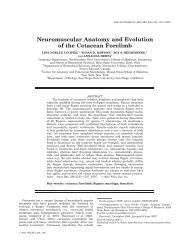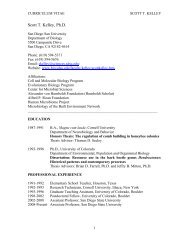Comparative anatomy and evolution of the odontocete forelimb
Comparative anatomy and evolution of the odontocete forelimb
Comparative anatomy and evolution of the odontocete forelimb
Create successful ePaper yourself
Turn your PDF publications into a flip-book with our unique Google optimized e-Paper software.
10 MARINE MAMMAL SCIENCE, VOL. **, NO. **, 2009<br />
Table 3. List <strong>of</strong> characters <strong>and</strong> character states in this study.<br />
Character State 0 State 1 State 2<br />
1. Scapula size Longer than wide Wider than long<br />
2. Scapula spine Prominent/long Reduced/absent<br />
3. Scapula acromion process Present/large Reduced/absent<br />
4. Scapula coracoid process Present Reduced/absent<br />
5. Length <strong>of</strong> humerus Long Short<br />
6. Humerus greater tubercle Present Reduced/absent<br />
7. Humerus lesser tubercle Present Reduced/absent<br />
8. Orientation <strong>of</strong> humeral Projects over ulnar Does not or only<br />
head<br />
edge<br />
slightly projects<br />
9. Gap between radius <strong>and</strong> Present Absent or not<br />
ulna<br />
significant<br />
10. Shape <strong>of</strong> ulna’s olecranon<br />
process<br />
Fan-shaped Blunt Paddle<br />
11. Polydactyly Absent Branched Interdigital<br />
12. Elongation <strong>of</strong> manus Absent Hyperphalangy<br />
13. Arrangement <strong>of</strong> digits Broad Narrow<br />
14. Shape <strong>of</strong> flipper Elongated Broad triangular Broad circular<br />
15. Shape <strong>of</strong> leading edge Straight/slightly Significantly curved Extremely<br />
curved<br />
curved<br />
16. Tip <strong>of</strong> flipper Rounded Pointed<br />
ancestor, D. atrox (primitive condition), with <strong>the</strong> state found in all o<strong>the</strong>r species. A<br />
list <strong>of</strong> characters <strong>and</strong> characters states is provided in Table 3.<br />
Scapular characters—Quantitative analysis allowed for <strong>the</strong> evaluation <strong>of</strong> scapular<br />
width vs. length (Table 2). The average measurement was used when multiple individuals<br />
were available for analysis. D. atrox possessed a scapula that is longer than<br />
wide (Uhen 2004). However, both mysticetes <strong>and</strong> <strong>odontocete</strong>s, evolved a scapula<br />
that is wider than long. Basal <strong>odontocete</strong>s, Physeter macrocephalus <strong>and</strong> Brygmophyseter<br />
shigensis on <strong>the</strong> o<strong>the</strong>r h<strong>and</strong>, retained <strong>the</strong> primitive condition.<br />
The spine was well developed in D. atrox (Uhen 2004), however, although it differs<br />
in size among extant taxa, most species exhibited a small or absent spine. Physeterids,<br />
Z. cavirostris, monodontids, <strong>and</strong> pilot whales exhibited a very small scapular spine.<br />
The smallest spines were found in Inia ge<strong>of</strong>frensis <strong>and</strong> Kogia breviceps. It has been<br />
reported that T. truncatus has no trace <strong>of</strong> this spine (Klima et al. 1987); however, this<br />
was not supported by this study. In some cases, <strong>the</strong> scapula also exhibited smaller,<br />
secondary spines (located posterior to <strong>the</strong> cardinal spine) that presumably allowed<br />
for a greater area <strong>of</strong> muscle attachment.<br />
The acromion <strong>and</strong> coracoid process <strong>of</strong> <strong>the</strong> scapula displayed differences in size <strong>and</strong><br />
shape. D. atrox had an acromion that is very small, curved, <strong>and</strong> narrow. The basal<br />
<strong>odontocete</strong> K. breviceps possessed an acromion that is long, massive, <strong>and</strong> becomes<br />
wider anteriorly. In contrast, K. simus possessed <strong>the</strong> narrowest acromion process that<br />
becomes only slightly broader anteriorly. Delphinapterus leucas exhibited a very long<br />
acromion that is proximally pointed as it extends anteriorly; whereas Globicephala<br />
macrorhynchus exhibited a process that is short <strong>and</strong> projects antero-proximally with<br />
a pointed end. The basilosaurid D. atrox, also possessed a coracoid process that is<br />
very large, robust, <strong>and</strong> medially curved (Uhen 2004). P. macrocephalus <strong>and</strong> I. ge<strong>of</strong>frensis<br />
had a long <strong>and</strong> flat coracoid process. Also, <strong>the</strong> results <strong>of</strong> this study for G. griseus




